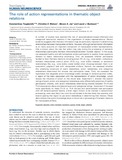| dc.description.abstract | A number of studies have explored the role of associative/event-based (thematic) and categorical (taxonomic) relations in the organization of object representations. Recent evidence suggests that thematic information may be particularly important in determining relationships between manipulable artifacts. However, although sensorimotor information is on many accounts an important component of manipulable artifact representations, little is known about the role that action may play during the processing of semantic relationships (particularly thematic relationships) between multiple objects. In this study, we assessed healthy and left hemisphere stroke participants to explore three questions relevant to object relationship processing. First, we assessed whether participants tended to favor thematic relations including action (Th+A, e.g., wine bottle—corkscrew), thematic relationships without action (Th-A, e.g., wine bottle—cheese), or taxonomic relationships (Tax, e.g., wine bottle—water bottle) when choosing between them in an association judgment task with manipulable artifacts. Second, we assessed whether the underlying constructs of event relatedness, action relatedness, and categorical relatedness determined the choices that participants made. Third, we assessed the hypothesis that degraded action knowledge and/or damage to temporo-parietal cortex, a region of the brain associated with the representation of action knowledge, would reduce the influence of action on the choice task. Experiment 1 showed that explicit ratings of event, action, and categorical relatedness were differentially predictive of healthy
participants’ choices, with action relatedness determining choices between Th+A and Th-A associations above and beyond event and categorical ratings. Experiment 2 focused more specifically on these Th+A vs. Th-A choices and demonstrated that participants with left temporo-parietal lesions, a brain region known to be involved in sensorimotor processing, were less likely than controls and tended to be less likely than patients with lesions sparing that region to use action relatedness in determining their choices. These data indicate that action knowledge plays a critical role in processing of thematic relations for manipulable artifacts. | en_UK |


